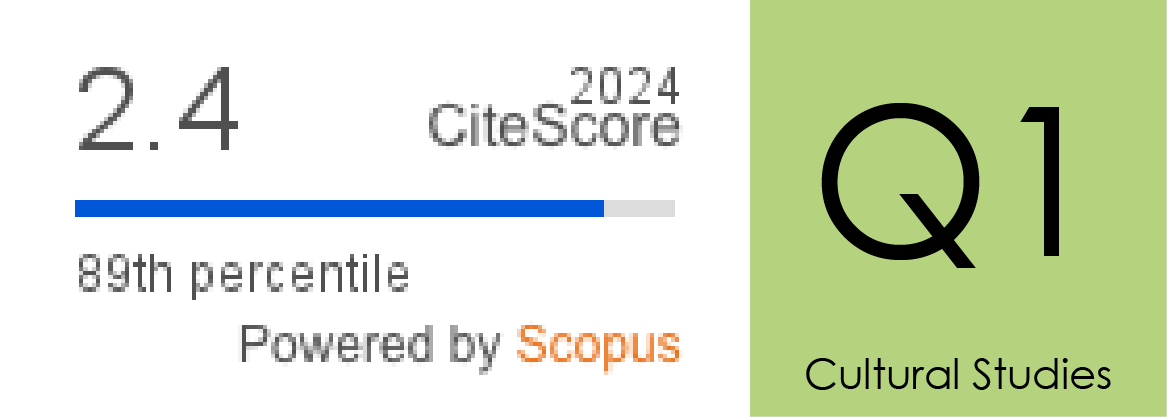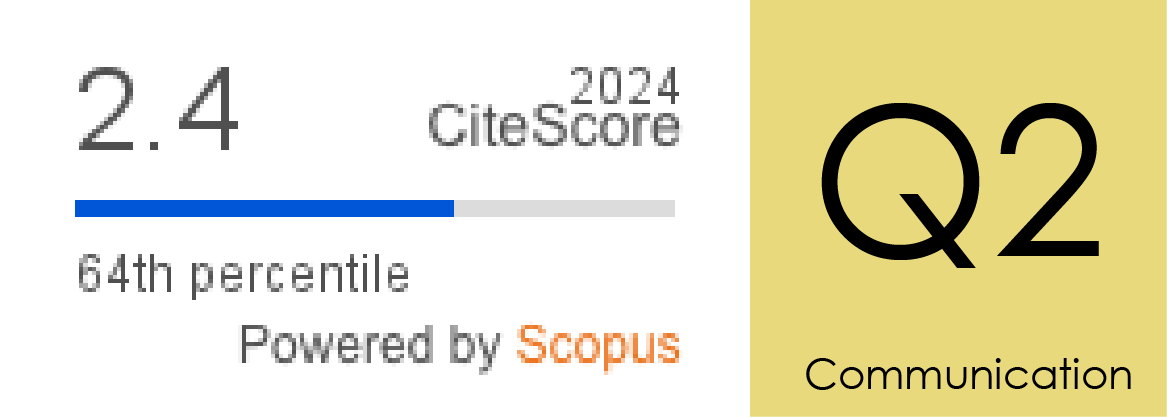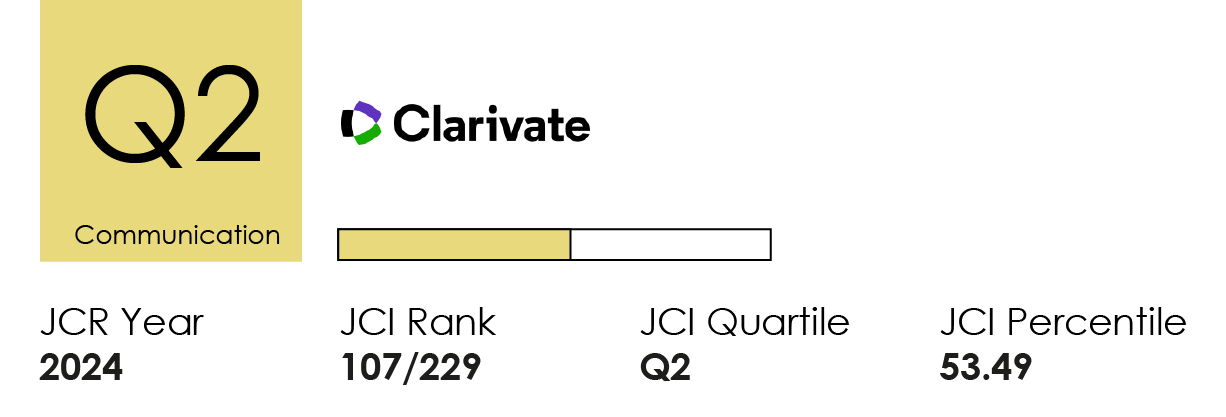Hábitos de uso y consumo de pantallas inteligentes entre niños/as de 7 a 9 años en España
DOI:
https://doi.org/10.14198/MEDCOM000009Palabras clave:
Niños/as y medios digitales, audiencias infantiles, teléfonos inteligentes, tablets, Investigación en comunicación infantil, usos y hábitos.Resumen
Este artículo presenta algunos de los resultados del proyecto de investigación “Niños, Apps, Tablets y Teléfonos Inteligentes de cero a nueve años. Los resultados fueron obtenidos en una encuesta a través de la plataforma Qualtrics —con control de calidad ESOMAR— a 525 niños/as de 7 a 9 años en ciudades de más de 10.000 habitantes y segmentado por CCAA, género, edad y renta familiar percibida. En el artículo, se realiza un análisis específico de variables descriptivas asociadas a género, edad, renta percibida y regiones y se contextualiza el trabajo con un análisis comparativo en España. Una de las conclusiones relevantes del estudio es establecer semejanzas y diferencias entre los patrones detectados en el uso de las pantallas inteligentes en nuestro país. También el abordaje y recomendaciones a la hora de trabajar con niños/as de edad temprana. Se concluye con recomendaciones orientadas a desarrollar un “Observatorio de los hábitos de uso y consumo de la infancia y adolescencia en las pantallas inteligentes”.
Financiación
Cátedra de Comunicación Digital por la infancia y la adolescencia, Observatorio de contenidos audiovisuales USALCitas
AIMC (2019). Quinto Estudio AIMC Niñ@s, 2019. https://bit.ly/2EudCBE
Ammari, T.; Kumar, P.; Lampe, C. & Schoenebeck, S. (2015). Managing children's online identities: How parents decide what to disclose about their children online. In Proceedings of the 33rd Annual ACM Conference on Human Factors in Computing Systems (pp. 1895-1904). Seoul, Republic of Korea: ACM. http://doi.org/d5rg
Ballano, S.; Uribe, A. C. & Munté-Ramos, R. A. (2014). Young users and the digital divide: readers, participants or creators on Internet? Communication & Society, 27(4), 147-155. http://doi.org/d5rh
Blackwell, C. K.; Lauricella, A. R.; Conway, A. & Wartella, E. (2014). Children and the internet: Developmental implications of web site preferences among 8 to 12-year-old children. Journal of Broadcasting & Electronic Media, 58(1), 1-20. http://doi.org/d5rr
Buckingham, D. (2013). Making Sense of the ‘Digital Generation’: Growing Up with Digital Media, Self & Society, 40(3), 7-15, http://doi.org/d5rs
Cost DigiLitEY. (2020). [Página Web]. https://bit.ly/2YI2VDb
Chester, J. (2015). How YouTube, big data and big brands mean trouble for kids and parents. Center for Digital Democracy. https://bit.ly/39DAJoP
Crescenzi-Lanna, L.; Valente, R. & Suárez-Gómez, R. (2019). Safe and inclusive educational apps: Digital protection from an ethical and critical perspective. Comunicar, 27(61). http://doi.org/d5rt
EUkidsonlilne (2020). EU Kinds Online 2020, Survey Results from 19 countries. https://bit.ly/3g662L1
Garmendia, M.; Jiménez, E.; Karrera, I.; Larrañaga, N.; Casado, M-A.; Martínez, G. y Garitaonandia, C. (2018). Actividades, mediación, oportunidades y riesgos de los menores en la era de la convergencia mediática. https://bit.ly/3dIKSRx
Garmendia, M.; Jiménez, E.; Karrera, I.; Larrañaga, N; Casado, M-A.; Martínez, G. y Garitaonandia, C. (2020). Las familias en la convergencia mediática: competencias, mediación, oportunidades y riesgos online. EU Kids Online. https://bit.ly/2Bo8n5h
Goodyear, V. A.; Armour, K. M. & Wood, H. (2018). Young people and their engagement with health-related social media: new perspectives. Sport, Education and Society, 24(7), 673-688. http://doi.org/d5rv
Haddon, L. & Livingstone, S. (2014). The Relationship between Offline and Online Risks. In von Feilitzen, C. & Stenersen, J. (Eds.), Young people, media and health: risks and rights. The Clearinghouse Yearbook (pp. 21-32). Nordicom. https://bit.ly/3cR70ZH
Holloway, D.; Green, L. & Livingstone, S. (2013). Zero to eight: young children and their internet use. London: EU Kids Online. https://bit.ly/3dGAWbi
INCIBE (2017). Guía de mediación parental. https://bit.ly/3hKw7jm
INE (2018). Encuesta de Condiciones de Vida (ECV) del Instituto Nacional de Estadística. Madrid: Instituto Nacional de Estadística. https://bit.ly/2YGN9Iv
Jiménez, E.; Garmendia, M. y Casado, M.A. (Coords.) (2018). Entre selfies y whatsapps. Oportunidades y riesgos para la infancia y la adolescencia conectada. Barcelona: Editorial Gedisa. http://doi.org/d5rw
Kardefelt-Whinther, D. (2014). A conceptual and methodological critique of internet addiction research: Towards a model of compensatory internet use. Computers in Human Behavior, 31, 351-354. http://doi.org/f5trp5
Lee, B.H. (2018). Explaining Cyber Deviance among School-Aged Youth. Child Indicators Research, 11, 563–584. http://doi.org/d5rj
Livingstone, S. (2013). Online risk, harm and vulnerability: reflections on the evidence base for child Internet safety policy. ZER: Journal of Communication Studies, 18(35), 13-28. https://bit.ly/31joCJD
Livingstone, S. & Helsper, E. (2013). Children, internet and risk in comparative perspective. Journal of Children and Media, 7(1), 1-8. http://doi.org/d5rx
Livingstone, S.; Ólafsson, K. & Staksrud, E. (2013). Risky social networking practices among ‘under-age’ users: lessons for evidence-based policy. Journal for Computer-Mediated Communication, 18(3), 303-320. http://doi.org/gdf32w
Livingstone, S. (2014). Risk and harm on the internet. In Jordan, A. & Romer, D. (Eds.), Media and the well-being of children and adolescents (pp. 129-146). Oxford: Oxford University Press.
Livingstone, S.; Mascheroni, G.; Ólafsson, K. & Haddon, L. (2014). Children’s online risks and opportunities: comparative findings from EU Kids Online and Net Children Go Mobile. London: EU Kids Online, LSE.
Livingstone, S.; Mascheroni, G.; Dreier, M.; Chaudron, S. & Lagae, K. (2015). How parents of young children manage digital devices at home: The role of income, education and parental style. London: EU Kids Online, LSE.
Livingstone, S. (2016). How can children be protected online when the internet has been designed for adults? In Children’s Rights and the Internet: From Guidelines to Practice (pp. 12-13). London: UNICEF
Livingstone, S.; Ólafsson, K.; Helsper, E.; Lupiáñez-Villanueva, F.; Veltri, G. A. & Folkvord, F. (2017). Maximizing opportunities and minimizing risks for children online: the role of digital skills in emerging strategies of parental mediation. Journal of Communication, 67(1), 82-105. http://doi.org/f9zfx5
Livingstone, S.; Tambini, D. & Belakova, N. (2018). Research for CULT Committee: recommendations for EU policy developments on the protection of minors in the digital age: in-depth analysis. Brussels: European Parliament, Policy Department for Structural and Cohesion Policie. https://bit.ly/3fbOSL3
Livingstone, S. (2020). Parenting for a digital future [Blog]. https://bit.ly/30a1aPG
Marsh, J.; Plowman, L.; Yamada-Rice, D.; Bishop, J. C. & Scott, F. (2016). Digital Play: A New Classification. Early Years: An International Journal, 36(3), 242-253. http://doi.org/gd8fc2
Mascheroni, G. & Holloway, D. (Eds.) (2017). The Internet of Toys: A report on media and social discourses around young children and IoToys. DigiLitEY. https://bit.ly/30UfDhW
Mascheroni, G. & Holloway, D. (2019). The quantified child: Discourses and practices of dataveillance in different life stages. In Erstad, O.; Flewitt, R.; Kümmerling-Meibauer, B. & Pires Pereira, I. (Eds.), The Routledge Handbook of Digital Literacies in Early Childhood. London: Routledge. http://doi.org/d5rm
McCrindle, M. (2014). The ABC of XYZ: Understanding the Global Generations”5. Bella Vista: McCrindle Research Pty Ltd.
McRoberts, S.; Bonsignore, E.; Peyton, T.; Yarosh, S. (2016). Do It for the Viewers!: Audience Engagement Behaviors of Young YouTubers. In Proceedings of the the 15th International Conference on Interaction Design and Children (pp. 334-343). ACM. http://doi.org/d5g2
Naciones Unidas (2006). Convención de los Derechos del Niño. https://bit.ly/3gd61W3
Nansen, B. & Jayemanne, D. (2016). Infants, Interfaces, and Intermediation: Digital Parenting and the Production of “iPad Baby” Videos on YouTube. Journal of Broadcasting and Electronic Media, 60(4), 587-603. http://doi.org/d5rn
Núñez -Gómez, P. y Larrañaga, K. (2020). El consumo y uso de dispositivos móviles por los niños y las niñas de la generación Alpha en España. https://bit.ly/31q7HH0
Ponte, C.; Castro, T. S. & Pereira, S. (2019). Parenting Young children in changing media environments with twenty years apart. Vita e Pensiero, 2. http://doi.org/d5rz
Sánchez, J. y Pintado, T. (2017). Nuevas tendencias en comunicación estratégica. Madrid: ESIC.
Sancho BBDO & Universidad Tadeo Lozano (2019). Centennials. Bogotá: UTadeo.
Souza-Araujo, C.; Almeida, V.; Doneda, D.; Hartung, P.; Magno, G. & Meira, W. (2017). Characterizing videos, audience and advertising in Youtube channels for kids. In International Conference on Social Informatics (pp. 341-359). Springer. http://doi.org/d5rp
Staksrud, E.; Ólafsson, K. & Livingstone, S. (2013). Does the use of social networking sites increase children’s risk of harm? Computers in Human Behavior, 29(1), 40-50. http://doi.org/f4jt82
Stoilova, M.; Nandagiri, R. & Livingstone, S. (2019). Children’s understanding of personal data and privacy online – a systematic evidence mapping. Information, Communication & Society. http://doi.org/d5rq
Tur-Viñes, V.; Núñez-Gómez, P. y Martínez-Pastor, E. (2019). YouTube, menores y cultura colaborativa. Revisión bibliográfica de la investigación académica en Historia y comunicación social, 24(1), 331-351. http://doi.org/drds
Valcke, M.; Bonte, S.; De Wever, B. & Rots, I. (2010). Internet parenting styles and the impact on Internet use of primary school children. Computers and Education, 55(2), 454–464. http://doi.org/d2hqmp
Yarosh, S.; Bonsignore, E.; McRoberts, S. & Peyton, T. (2016). YouthTube: youth video authorship on YouTube and Vine. In Proceedings of the 19th ACM Conference on Computer-Supported Cooperative Work & Social Computing (pp. 1423-1437). ACM. http://doi.org/d5gz
YouTube press (2018). https://bit.ly/3gtuJlb
Yubero, S.; Larrañaga, E.; Navarro, R. & Elche, M. (2018). Parents, children and Internet use. Family socialization on the Internet. Universitas Psychologica, 17(2). http://doi.org/d5r2
Descargas
Estadísticas
Publicado
Cómo citar
Número
Sección
Licencia
Derechos de autor 2021 Patricia Núñez-Gómez, Félix Ortega-Mohedano, Kepa Larrañaga-Martínez

Esta obra está bajo una licencia internacional Creative Commons Atribución-CompartirIgual 4.0.
Los autores y autoras que publican en esta revista están de acuerdo con los siguientes términos:
1 Derechos de autor. Los autores y autoras conservan sus derechos de autor, aunque ceden a la revista de forma no exclusiva los derechos de explotación (reproducción, distribución, comunicación pública y transformación) y garantizan a esta el derecho de primera publicación de su trabajo, el cual estará simultáneamente sujeto a la licencia indicada en punto 2. Los autores pueden establecer otros acuerdos adicionales para la distribución no exclusiva de la versión de la obra publicada en la revista, siempre que exista un reconocimiento de su publicación inicial en esta revista.
© Los autores.
2 Licencia. Los trabajos se publican en la revista sujetos a la licencia de Reconocimiento 4.0 Internacional de Creative Commons (CC BY 4.0); los términos se pueden consultar en https://creativecommons.org/licenses/by/4.0/
Esta licencia permite a terceros compartir (copiar y redistribuir el material en cualquier medio o formato) y adaptar (remezclar, transformar y crear a partir del material para cualquier finalidad, incluso comercial), siempre que se reconozca la autoría y la primera publicación en esta revista (Revista Mediterránea de Comunicación (RMC) / Mediterranean Journal of Communication (MJC), Universidad de Alicante, DOI de la obra), se proporcione un enlace a la licencia y se indique si se han realizado cambios en la obra.
3 Política de autoarchivo. Se recomienda a los autores que difundan sus trabajos a través de Internet para favorecer una circulación y difusión más rápidas y, con ello, un posible aumento en la citación y alcance entre la comunidad científica y académica, en las siguientes condiciones:
No se permite a los autores depositar en un repositorio institucional o temático, página web propia, etc., las versiones preprint (versión antes de ser evaluada) o postprint (versión evaluada y aceptada para su publicación) de sus trabajos antes de su publicación, pero sí el artículo final publicado (versión del editor).













